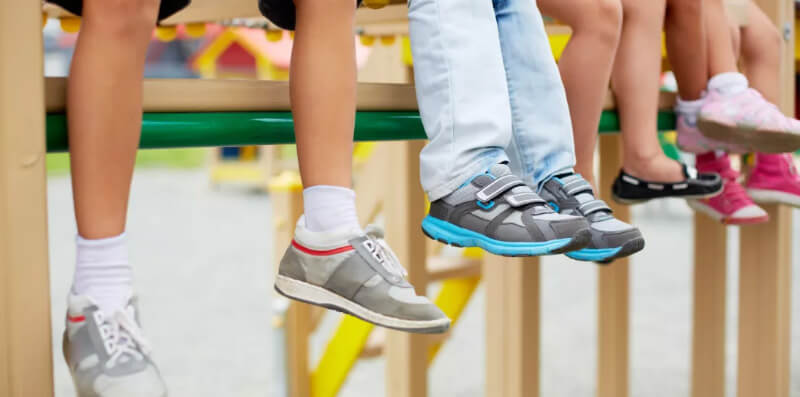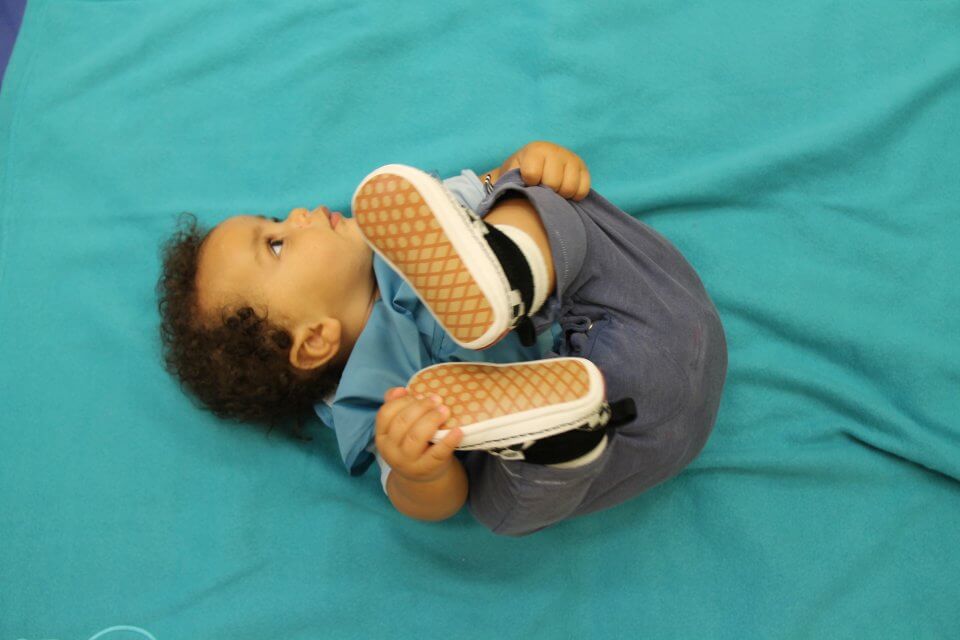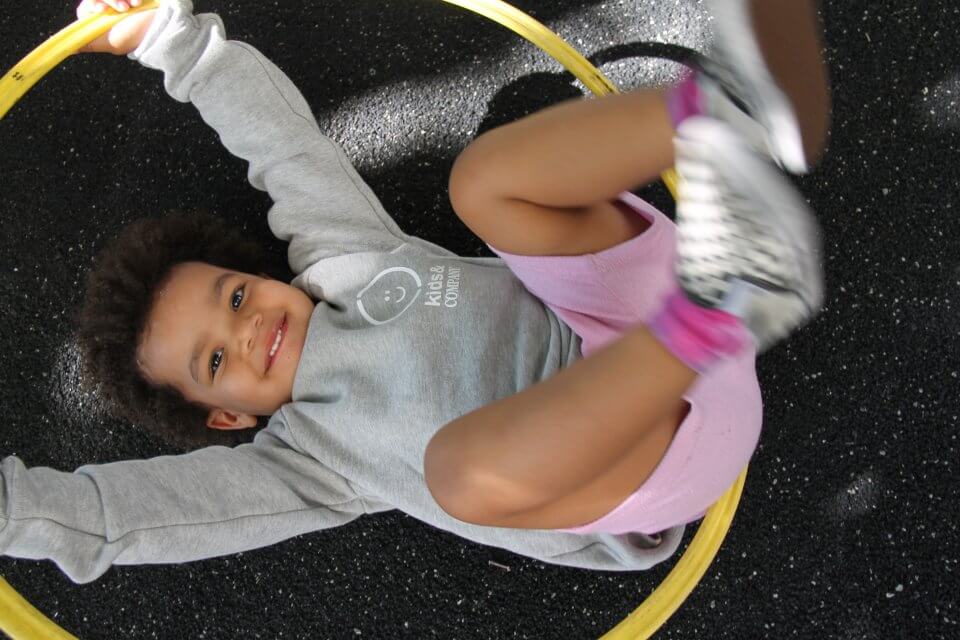Kids & Company Blog
Want the Best Shoes for Your Kids? 5 Expert Tips for Back-To-School Shopping
Written by Dr. Michael Ryan
Director of R&D, Kintec
You don’t need an expert to tell you how fast your kids (and their feet) grow! In fact, it’s not unusual for children’s feet to grow up to two sizes in one year. No wonder parents feel like they’re always shopping for new shoes.
With the added pressure of so many brands and features, it can be difficult to determine which shoes are best for your kids.

Kid’s Growing Feet are Different Than Yours — Their Shoes Should be Too
For starters, it helps to understand that your kid’s feet aren’t just miniature versions of yours. During the infant and early childhood years, bones in the feet are not yet calcified (hardened like adult bone), and ligaments and joints are much more flexible. As a result, children’s feet are more agile, and when they stand, their feet often appear flatter than an adult’s.
As children grow and become more active, their bones harden, ligaments tighten, and muscles strengthen, increasing the relative height of their arches. Most pediatric specialists agree that children’s feet mature between the ages of 13 and 16.
To find the perfect fit at every stage of your child’s development, we’ll help you find a shoe that not only fits and feels good but also matches their activities, prevents injury, promotes healthy development, and helps them stay active on their feet, for life.
5 Expert Tips for Back-To-School Shopping
TIP #1: Less is More
Research increasingly shows that for healthy development, children’s shoes should support the natural movement of the foot. This means a more flexible shoe is best (compared to a stiffer, more structured shoe that hinders natural movement).
Shoes that are more flexible, and allow for the natural movement of the foot, support the development of higher arched feet (healthy arch heights) and larger foot muscles, and reduce the risk of experiencing foot pain.
Studies also show that when kids walk on different surfaces and uneven terrain, it actually helps strengthen their small foot muscles. The best shoes have features that protect the skin under foot, rather than limit natural movement.
For back-to-school shopping, remember protection is important but not at the expense of flexibility.

TIP #2: Cramped Toes Can Cause Big (Bunion) Problems
Further proof that mom and grandma are not the only ones to blame for bunions!
Toes need room to wiggle and move inside a shoe, and not just for comfort. When a shoe is too short, children’s toes get cramped and flexed within the toe box of the shoe, which can impact the positioning and development of the big toe.
In a study of 858 school children, the majority were wearing indoor shoes that were two sizes too small, which increased the risk of bunion development. The research showed that the smaller the shoe, the greater the risk of bunions, for example, if your child is wearing a shoe that is two sizes too small their risk of bunion development is 37%!
For the perfect fit, see a Kintec Fit Expert for accurate measurements and proper footwear sizing for your child.
TIP #3: Bigger is Not Better
Kids' feet grow so fast, parents may be tempted to buy shoes that are too big so they can “grow into them.” Big shoes are not only a tripping hazard, but can also cause pain, discomfort, and increase the risk of future problems.
The best shoes are specifically designed with a flex point that aligns with the natural flex point of your child’s foot when they walk. When a shoe is too big, the flex point will be in the wrong spot, forcing the foot to bend at an unnatural point.
For the perfect fit, there should be about half the width of your thumbnail from the end of their longest toe to the end of the shoe. If your children’s feet aren’t the same size, buy shoes to accommodate the bigger of the two.
TIP #4: “Breaking-In” is Bad
Shoes should feel comfortable the first time your child tries them on. Don’t allow for a “break-in period” or expect shoes to get more comfortable over time. The best shoes for your kids are the ones that feel good, fit right, match their activities, and support the healthy development of their feet.
Keep in mind: Kids don’t always know how to describe specific pain points or discomfort, so it’s important to see a Fit Expert who can help fit them properly each time they get a new pair of shoes.

TIP #5: Injured Feet Need Special Attention
If your children suffer from foot aches, pains or injury, specialized footwear can reduce pain and help your child heal and return to their daily activities.
Calcaneal apophysitis, also known as Sever’s disease, commonly occurs between the ages of 8 and 15. Microtrauma and repetitive stress to the growth plate leads to inflammation and discomfort, specifically where the Achilles tendon inserts into the heel. Your child’s shoe can help reduce trauma by absorbing the contact forces during running and jumping activities. Research suggests that one year post-diagnosis, footwear, heel lifts, and custom orthotics are all effective treatments for children with clinically diagnosed calcaneal apophysitis.
For children diagnosed with juvenile idiopathic arthritis (JIA), footwear can help reduce inflammation, pain, and improve mobility during everyday activities. 30-50% of children diagnosed with JIA experience persistent inflammation into adulthood. Arthritic flare-ups can cause joint pain, stiffness and inflammation. Proper footwear and custom orthotics have been shown to reduce pain and improve function, thus helping your kids stay active on their feet.
If your child is complaining of foot or heel pain, we recommend an assessment with one of our Canadian Certified Pedorthists.
Want to learn more about Kinetic or book an assessment? Visit Kintec Footwear & Orthotics!
References
UDEN H, SCHARFBILLIG R, CAUSBY R. THE TYPICALLY DEVELOPING PAEDIATRIC FOOT: HOW FLAT SHOULD IT BE? A SYSTEMATIC REVIEW. THE JOURNAL OF FOOT ANKLE AND ANKLE RESEARCH. 2017 AUG 15;10:37. DOI: 10.1186/S13047-017-0218-1.
KLEIN C, GROLL-KNAPP E, KUNDI M, KINZ W. INCREASED HALLUX ANGLE IN CHILDREN AND ITS ASSOCIATION WITH INSUFFICIENT LENGTH OF FOOTWEAR: A COMMUNITY BASED CROSS-SECTIONAL STUDY. BMC MUSCULOSKELET DISORD. 2009;10:159. PUBLISHED 2009 DEC 17. DOI:10.1186/1471-2474-10-159.
JAMES AM, WILLIAMS CM, HAINES TP. HEEL RAISES VERSUS PREFABRICATED ORTHOSES IN THE TREATMENT OF POSTERIOR HEEL PAIN ASSOCIATED WITH CALCANEAL APOPHYSITIS (SEVER’S DISEASE): A RANDOMISED CONTROL TRIAL. JOUNRAL OF FOOT AND ANKLE RESEARCH. 2010;3:3. PUBLISHED 2010 MAR 2. DOI:10.1186/1757-1146-3-3.
HOLLANDER K, DE VILLIERS JE, SEHNER S, ET AL. GROWING-UP (HABITUALLY) BAREFOOT INFLUENCES THE DEVELOPMENT OF FOOT AND ARCH MORPHOLOGY IN CHILDREN AND ADOLESCENTS. SCIENTIFIC REPORTS. 2017;7(1):8079. PUBLISHED 2017 AUG 14. DOI:10.1038/S41598-017-07868-4
Posted on: Friday August 20th, 2021
Posted by: Kids & Company
Calgary
Calgary
Calgary
Calgary
Calgary
Edmonton
Cochrane
Red Deer
Calgary
Calgary
Okotoks
Calgary
Calgary
Calgary
Calgary
Edmonton
St. Albert
Edmonton
Edmonton
Edmonton
Edmonton
Edmonton
Edmonton
Edmonton
St. Albert
Edmonton
Edmonton
Sylvan Lake
Edmonton
Sherwood Park
Edmonton
Calgary
Edmonton
Calgary
Edmonton
Kamloops
Langley
Langley
New Westminster
North Vancouver
Richmond
Vancouver
Victoria
Victoria
Port Moody
Surrey
Surrey
Surrey
North Vancouver
Nanaimo
Surrey
Coquitlam
Burnaby
Port Coquitlam
Vancouver
Maple Ridge
Maple Ridge
Maple Ridge
Mission
Maple Ridge
Maple Ridge
Maple Ridge
Maple Ridge
Mission
Mission
Maple Ridge
Maple Ridge
Chicago
Chicago
Chicago
Chicago
Schaumburg
Chicago
Winnipeg
Abington
Canton
Quincy
West Quincy
Braintree
Braintree
Walpole
East Walpole
Brighton
Brookline
Jamaica Plain
Jamaica Plain
Cambridge
Needham
Newton Highlands
Newton
Cambridge
Boston
Randolph
Kingston
St. Peters
Lake St. Louis
Troy
O'Fallon
St. Charles
Lake St. Louis
St. Peters
O'Fallon
Howell Township
Freehold Township
Manalapan Township
Stratford
Marlton
West Deptford
Bedford
Dartmouth
Halifax
Bedford
Hammonds Plains
Lower Sackville
Eastern Passage
Avon Lake
Beachwood
Hudson
Medina
Strongsville
Cleveland
Westlake
Aurora
Burlington
Burlington
Etobicoke
Etobicoke
Hamilton
London
Milton
Mississauga
Ottawa
Richmond Hill - Corporate office (No child care services)
Toronto
Toronto
Toronto
Toronto
Toronto
Waterloo
Kanata
Oakville
Oakville
Toronto
Whitby
Toronto
Mississauga
Ottawa
Toronto
Toronto
Toronto
Brampton
Stoney Creek
Toronto
Nepean
Burlington
Burlington
Oakville
Waterdown
Oakville
Pittston
Wilkes-Barre
Exeter
Old Forge
Dover
Harrisburg
Harrisburg
Harrisburg
Hummelstown
Palmyra
York
York
York
Sweet Kiddles Avon Lake, part of the Kids & Company Family
Abington
Aurora
Sweet Kiddles Beachwood, part of the Kids & Company Family
Bedford (Dellridge Lane)
Larry Uteck (Southgate Dr)
Pine Village South End, by Kids & Company
Braintree 1
Braintree 2
Brampton
Pine Village Brighton, by Kids & Company
Pine Village Brookline, by Kids & Company
Burlington Children’s Centre
Burloak
Appleby
Beacon Hill
Brightstart Burnaby, by Kids & Company
Bow Trail
Livingston
Midlake
Millrise
Royal Oak
Britannia Crossing
Marda Loop
Evanston
Beltline
Aviation Crossing
Gulf Canada Square
Royal Oak Out of School Care and Child Care
Glendeer: New – Open for Enrollment
Pine Village Kendall Square, by Kids & Company
Pine Village Porter Square, by Kids & Company
Canton
Jackson
Lincoln Park
Harrison
West Loop
Fulton
Sweet Kiddles University Circle, part of the Kids & Company Family
Cochrane
Brightstart Coquitlam, by Kids & Company
Dartmouth
Dover
Walpole North
Eastern Passage
Ellerslie
Edmonton Ice District
Baturyn
Diamond
Friendly Frog
Meadowlark Park
St. Charles
St. Dominic
Sunshine Factory
Tamarack
Jagare Ridge
Horse Hill
Fraser
Century Park: New – Open for Enrollment
Grandview Heights
Islington
Etobicoke (Bloor & Islington)
ABC Kiddie Kampus Exeter, by Kids & Company
Apple Hill Academy Freehold by Kids & Company
Halifax
Hamilton
Hammonds Plains
Route 39
Schaffner
Swatara
Apple Hill Academy Howell by Kids & Company
Sweet Kiddles Hudson, part of the Kids & Company Family
Hummelstown
Pine Village JP Revere, by Kids & Company
Pine Village JP South Street, by Kids & Company
Kamloops
Eagleson (South Kanata)
Crayon College, by Kids & Company
Tyke Town Lake St. Louis, by Kids & Company
ABC Lake St. Louis, by Kids & Company
Kids World
Langley (200th St.)
London Richmond
Sackville
Apple Hill Academy Manalapan by Kids & Company
Little Willows 119 Avenue, by Kids & Company
Little Willows Dewdney House (Infant/Toddler and 3-5), by Kids & Company
Little Willows Dewdney Church (Preschool/OSC/3-5), by Kids & Company
Little Willows Edge, by Kids & Company
Little Willows Webster’s Corner, by Kids & Company
Little Willows Harry Hooge, by Kids & Company
Little Willows Alouette, by Kids & Company
Little Willows Silver Valley, by Kids & Company
Little Willows Whonnock, by Kids & Company
Under The Sun Marlton, part of the Kids & Company Family
Sweet Kiddles Medina, part of the Kids & Company Family
Milton
Little Willows Lougheed, by Kids & Company
Little Willows Stave Falls, by Kids & Company
Little Willows Briskham, by Kids & Company
Robert Speck Parkway
Mississauga Gateway Centre
Nanaimo
Pine Village Needham, by Kids & Company
Ottawa Barrhaven
New Westminster
Pine Village West Newton, by Kids & Company
Pine Village Newton Highlands, by Kids & Company
North Vancouver
North Van Esplanade
O’Fallon South
ABC O’Fallon, by Kids & Company
Oakville Cornwall
Oakville Dundas
Joshua Creek
Oakville West (3537 Wyecroft Rd)
Okotoks
ABC Kiddie Kampus Old Forge, by Kids & Company
Ottawa Albert
Ottawa Westboro
Palmyra
ABC Kiddie Kampus Pittston, by Kids & Company
Brightstart Port Coquitlam, by Kids & Company
Port Moody
Marina Bay
Randolph
Red Deer
Richmond
Head Office
Schaumburg
Sherwood Park
St. Albert North
St. Albert Grandin
ABC St. Charles, by Kids & Company
Tyke Town St. Peters, by Kids & Company
ABC St. Peters, by Kids & Company
Stoney Creek
Under The Sun Stratford, part of the Kids & Company Family
Sweet Kiddles Strongsville, part of the Kids & Company Family
Morgan Crossing
Surrey Professional Centre
King George
Brightstart Cloverdale, by Kids & Company
Sylvan Lake
Bloor Christie
Bloor (Bloor St. East)
Consumers
Finch
Front
Scotia Plaza
Stockyards
St. Andrew’s Church
Liberty Village
Rosedale
Queen West
Tyke Town Troy, by Kids & Company
Vancouver West
Cambie
Langford
Victoria
Walpole South
Waterdown
Tech Town
Under The Sun West Deptford, part of the Kids & Company Family
West Quincy
Sweet Kiddles Westlake, part of the Kids & Company Family
Whitby
ABC Kiddie Kampus East Mountain, by Kids & Company
Winnipeg
West York
Queen Street
Keystone Early Learning Academy, part of the Kids & Company Family
Calgary
Calgary
Calgary
Calgary
Calgary
Edmonton
Cochrane
Red Deer
Calgary
Calgary
Okotoks
Calgary
Calgary
Calgary
Calgary
Edmonton
St. Albert
Edmonton
Edmonton
Edmonton
Edmonton
Edmonton
Edmonton
Edmonton
St. Albert
Edmonton
Edmonton
Sylvan Lake
Edmonton
Sherwood Park
Edmonton
Calgary
Edmonton
Calgary
Edmonton
Kamloops
Langley
Langley
New Westminster
North Vancouver
Richmond
Vancouver
Victoria
Victoria
Port Moody
Surrey
Surrey
Surrey
North Vancouver
Nanaimo
Surrey
Coquitlam
Burnaby
Port Coquitlam
Vancouver
Maple Ridge
Maple Ridge
Maple Ridge
Mission
Maple Ridge
Maple Ridge
Maple Ridge
Maple Ridge
Mission
Mission
Maple Ridge
Maple Ridge
Chicago
Chicago
Chicago
Chicago
Schaumburg
Chicago
Winnipeg
Abington
Canton
Quincy
West Quincy
Braintree
Braintree
Walpole
East Walpole
Brighton
Brookline
Jamaica Plain
Jamaica Plain
Cambridge
Needham
Newton Highlands
Newton
Cambridge
Boston
Randolph
Kingston
St. Peters
Lake St. Louis
Troy
O'Fallon
St. Charles
Lake St. Louis
St. Peters
O'Fallon
Howell Township
Freehold Township
Manalapan Township
Stratford
Marlton
West Deptford
Bedford
Dartmouth
Halifax
Bedford
Hammonds Plains
Lower Sackville
Eastern Passage
Avon Lake
Beachwood
Hudson
Medina
Strongsville
Cleveland
Westlake
Aurora
Burlington
Burlington
Etobicoke
Etobicoke
Hamilton
London
Milton
Mississauga
Ottawa
Richmond Hill - Corporate office (No child care services)
Toronto
Toronto
Toronto
Toronto
Toronto
Waterloo
Kanata
Oakville
Oakville
Toronto
Whitby
Toronto
Mississauga
Ottawa
Toronto
Toronto
Toronto
Brampton
Stoney Creek
Toronto
Nepean
Burlington
Burlington
Oakville
Waterdown
Oakville
Pittston
Wilkes-Barre
Exeter
Old Forge
Dover
Harrisburg
Harrisburg
Harrisburg
Hummelstown
Palmyra
York
York
York
Sweet Kiddles Avon Lake, part of the Kids & Company Family
Abington
Aurora
Sweet Kiddles Beachwood, part of the Kids & Company Family
Bedford (Dellridge Lane)
Larry Uteck (Southgate Dr)
Pine Village South End, by Kids & Company
Braintree 1
Braintree 2
Brampton
Pine Village Brighton, by Kids & Company
Pine Village Brookline, by Kids & Company
Burlington Children’s Centre
Burloak
Appleby
Beacon Hill
Brightstart Burnaby, by Kids & Company
Bow Trail
Livingston
Midlake
Millrise
Royal Oak
Britannia Crossing
Marda Loop
Evanston
Beltline
Aviation Crossing
Gulf Canada Square
Royal Oak Out of School Care and Child Care
Glendeer: New – Open for Enrollment
Pine Village Kendall Square, by Kids & Company
Pine Village Porter Square, by Kids & Company
Canton
Jackson
Lincoln Park
Harrison
West Loop
Fulton
Sweet Kiddles University Circle, part of the Kids & Company Family
Cochrane
Brightstart Coquitlam, by Kids & Company
Dartmouth
Dover
Walpole North
Eastern Passage
Ellerslie
Edmonton Ice District
Baturyn
Diamond
Friendly Frog
Meadowlark Park
St. Charles
St. Dominic
Sunshine Factory
Tamarack
Jagare Ridge
Horse Hill
Fraser
Century Park: New – Open for Enrollment
Grandview Heights
Islington
Etobicoke (Bloor & Islington)
ABC Kiddie Kampus Exeter, by Kids & Company
Apple Hill Academy Freehold by Kids & Company
Halifax
Hamilton
Hammonds Plains
Route 39
Schaffner
Swatara
Apple Hill Academy Howell by Kids & Company
Sweet Kiddles Hudson, part of the Kids & Company Family
Hummelstown
Pine Village JP Revere, by Kids & Company
Pine Village JP South Street, by Kids & Company
Kamloops
Eagleson (South Kanata)
Crayon College, by Kids & Company
Tyke Town Lake St. Louis, by Kids & Company
ABC Lake St. Louis, by Kids & Company
Kids World
Langley (200th St.)
London Richmond
Sackville
Apple Hill Academy Manalapan by Kids & Company
Little Willows 119 Avenue, by Kids & Company
Little Willows Dewdney House (Infant/Toddler and 3-5), by Kids & Company
Little Willows Dewdney Church (Preschool/OSC/3-5), by Kids & Company
Little Willows Edge, by Kids & Company
Little Willows Webster’s Corner, by Kids & Company
Little Willows Harry Hooge, by Kids & Company
Little Willows Alouette, by Kids & Company
Little Willows Silver Valley, by Kids & Company
Little Willows Whonnock, by Kids & Company
Under The Sun Marlton, part of the Kids & Company Family
Sweet Kiddles Medina, part of the Kids & Company Family
Milton
Little Willows Lougheed, by Kids & Company
Little Willows Stave Falls, by Kids & Company
Little Willows Briskham, by Kids & Company
Robert Speck Parkway
Mississauga Gateway Centre
Nanaimo
Pine Village Needham, by Kids & Company
Ottawa Barrhaven
New Westminster
Pine Village West Newton, by Kids & Company
Pine Village Newton Highlands, by Kids & Company
North Vancouver
North Van Esplanade
O’Fallon South
ABC O’Fallon, by Kids & Company
Oakville Cornwall
Oakville Dundas
Joshua Creek
Oakville West (3537 Wyecroft Rd)
Okotoks
ABC Kiddie Kampus Old Forge, by Kids & Company
Ottawa Albert
Ottawa Westboro
Palmyra
ABC Kiddie Kampus Pittston, by Kids & Company
Brightstart Port Coquitlam, by Kids & Company
Port Moody
Marina Bay
Randolph
Red Deer
Richmond
Head Office
Schaumburg
Sherwood Park
St. Albert North
St. Albert Grandin
ABC St. Charles, by Kids & Company
Tyke Town St. Peters, by Kids & Company
ABC St. Peters, by Kids & Company
Stoney Creek
Under The Sun Stratford, part of the Kids & Company Family
Sweet Kiddles Strongsville, part of the Kids & Company Family
Morgan Crossing
Surrey Professional Centre
King George
Brightstart Cloverdale, by Kids & Company
Sylvan Lake
Bloor Christie
Bloor (Bloor St. East)
Consumers
Finch
Front
Scotia Plaza
Stockyards
St. Andrew’s Church
Liberty Village
Rosedale
Queen West
Tyke Town Troy, by Kids & Company
Vancouver West
Cambie
Langford
Victoria
Walpole South
Waterdown
Tech Town
Under The Sun West Deptford, part of the Kids & Company Family
West Quincy
Sweet Kiddles Westlake, part of the Kids & Company Family
Whitby
ABC Kiddie Kampus East Mountain, by Kids & Company
Winnipeg
West York
Queen Street
Keystone Early Learning Academy, part of the Kids & Company Family




